Asurini do Xingu
- Self-denomination
- Awaete
- Where they are How many
- PA 219 (Siasi/Sesai, 2020)
- Linguistic family
- Tupi-Guarani
After contact with Brazilian society in 1971, the Asurini of the Xingu – so-called by the attraction expeditions – suffered a drastic population loss. Yet, the imminent danger of their physical extinction always stood in contrast with an extreme cultural vitality, manifest in the performance of complex rituals, the practice of shamanism, and an elaborate system of graphic art.
Name
Since the 19th Century, the Indians who predominated in the region between the Xingu and Bacajá rivers – today known as the Araweté, Arara, and Parakanã – were called Asurini (Asonéri, in the language of the Juruna Indians), which means "red", according to the ethnographer Curt Nimuendajú (1963c: 225). The right bank of the Xingu River has always been called the "Land of the Assuriní" by the inhabitants of the city of Altamira and other dwellers of the middle Xingu (Lukesch,1976:11 and Soares,1971b:3). The French traveller Henri Coudreau (1977:37) also cites the Asurini as one of the groups who inhabited the Lower Xingu.
According to Nimuendajú (1963c:225), the name given by the Kayapó to the Asurini is Kub(ẽ)-Kamrég-ti, (Kub(ẽ) meaning "Indian"; Kamrég-ti, "red"; ti, augmentative). According to the Xikrin of Bacajá (a Kayapó subgroup), the name they give to the Asurini is Krã-akâro (head with rounded haircut, or round head). Nimuendaju mentions the Asurini and Asurinikin as other names for the group, as well as Surini, in the Juruna language; Adgí Kaporuri-ri (adji, "savage", Kaporurí, "red", ri, "very"), in the Xipáia language; and Nupánunupag (Nupánu, "Indian"; pag "red"), in the Kuruaia language.
On contacting the Indians of the Ipiaçava stream, the Catholic missionary and ethnologist Anton. Lukesch called them Asurini, because they spoke Tupi and were "red Indians", due to their abundant use of urucum, a vegetal dye (1976:42). Antonio Cotrim, a Funai (National Indian Foundation) indigenist, who continued the contacts initiated by Lukesch, also called them Asurini (1971b). This name is accepted by Funai, which has used it even up to the present day. They are also known as the Asurini of the Xingu, diferentiating them from the Asurini of the Tocantins River region (Akuáwa Asurini).
The self-designation of the group is Awaeté, which means the "true people" (Awa= people, eté = suffix that gives emphasis like "true", "very"). To the Whites, they call themselves At(*s)urini, from the word asuruni, the name given to them by the attraction expeditions.
Language
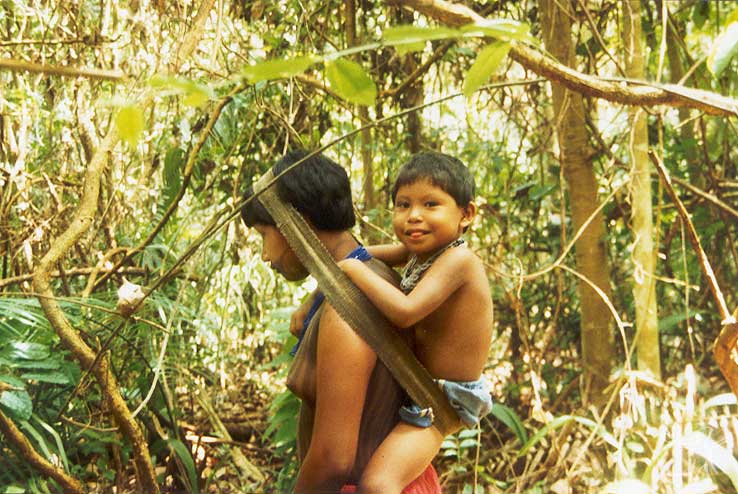
The Asurini language belongs to the Tupi-Guarani language family, classified, according to the linguist Aryon Rodrigues (1984), in subset V, to which the Kayabi language also belongs. Velda Nicholson, of the SIL (International Linguistics Society, formerly Summer Institute of Linguistics), has studied the language of the Asurini of the Tocantins River and compared it with the language of the Asurini of the Xingu (1982), demonstrating similarities and differences in phonology, and morphological and grammatical rules.
In 1998, Ruth Monserrat, of the Museu Nacional (Rio de Janeiro), with the assistance of the Little Sisters of Jesus, a missionary order, and support of the Indigenist Missionary Council (CIMI), published an Asurini grammar which is currently being utilized by teachers in the school of Koatinemo village. Thus, all Asurini speak their language, while all those less than 40 years of age are bilingual.
Location
The only existing village is located on the right bank of the Xingu River, within the Koatinemo Indigenous reserve, legally demarcated and homologated in 1986. From 1972 to 1985, the village was located on the banks of the Ipiaçava stream, tributary of the right bank of the Xingu. Asurini gardens, hunting, fishing, and gathering places are situated between the banks of the Xingu and Piranhaquara rivers and the Piaçava stream. From time to time, they go to the headwaters of the Xingu, where their ancient villages were located (Mancin, 1979b:1-20).
Population
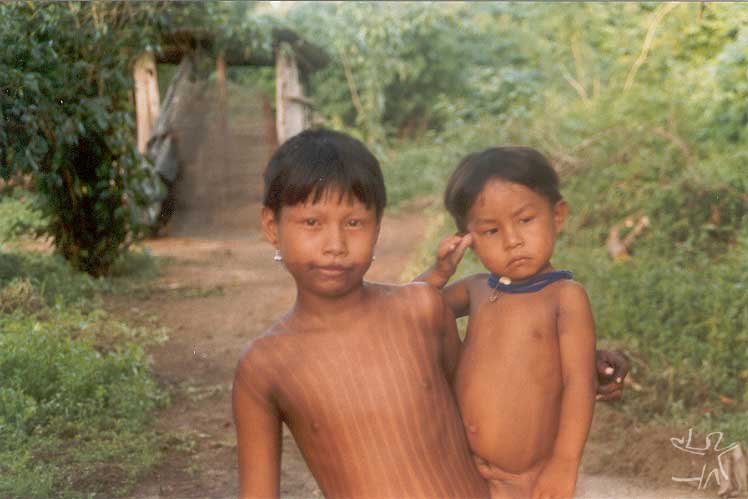
According to information obtained from the Asurini and estimates made by the anthropologist Berta Ribeiro (1982), around 1930, the group had an approximate population of 150 individuals. From then until the year they were contacted (1971), many Asurini were killed in conflicts with the Kayapó or the Araweté, when women and children were also taken captive.
Following contact with attraction expeditions, the population of the Asurini of the Xingu declined nearly 50% by 1982, mainly because of the effects of new sicknesses transmitted by the Whites who participated in these expeditions but were totally unprepared to encounter a non-immunized population. In 1971, the Asurini population was approximately 100 individuals; by 1982, it had fallen to 52. By 1992, there were 66 Asurini and, in 1994, this number had risen to 72. Presently, the population is comprised of 33 women, 18 men, and 55 young men and children, totalling 106 individuals. In large part, the demographic recovery is due to an increase of the infant population and, consequently, a change in the pattern of family composition, along with interethnic marriages.
History of contact
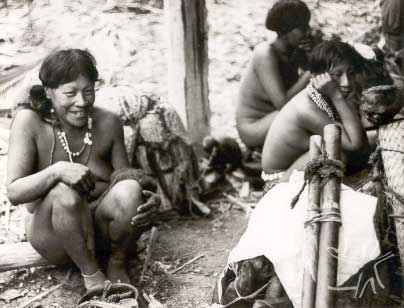
The first reports of the Asurini date from the end of the 19th Century. In 1894, an attack on a group of non-indigenous people at the place called Praia Grande, above the mouth of the Bacajá River, was attributed to the Asurini Indians (Nimuendajú,1963c:225). In 1896, according to the French traveller H. Coudreau, the Asurini attacked at Serra do Passahy and on Praia Grande (1977:37). There were still confirmed attacks by the Asurini on the banks of the Bacajá River at the end of the 19th Century (Nimuendajú,1963c:225). In this period, the Asurini were also attacked several times by the Whites (probably rubber extractors) who set fire to their villages (Mancin,1979b:2).
From the banks of the Bacajá River, they moved in the direction of the headwaters of the Ipiaçava e Piranhaquara rivers, where they built several villages. In 1931, there is a report of an attack by the Asurini at the mouth of the Bom Jardim stream. In 1936, they were attacked by the Gorotire, a Kayapó subgroup, in their expansion to the north (Nimuendajú,1963c:225). Pressured by the Kayapó, the Asurini finally settled for a long time on the banks of the Ipixuna River.
Between 1965 and 1970, the Asurini were forced out of this area by the Indians whom they called Ararawa (Araweté). There are reports that the Xikrin of the Bacajá attacked the Asurini in 1966 (Cotrim, 1971b and Lukesch,1971:13) in the region of the Rio Branco, tributary of the Bacajá. In the 1960s, the hunting of wildcats and rubber extraction led the regional population to move further up the tributaries of the right bank of the Xingu, provoking hostile encounters with the indigenous population. Reoccupying the region of the Ipiaçava and Piranhaquara rivers, the Asurini continued their hostile relations with the Whites, although in rapid and fleeting encounters.
The Asurini pillaged the camps of the Whites to get metal goods (machetes, axes, etc.). In the 1970s, the presence of the Whites intensified in the area with the purpose of contacting the indigenous groups of the region and as a result of the emergence of new economic activities: mining, cattle ranching, and government projects (especially the construction of the Trans-Amazon Highway).
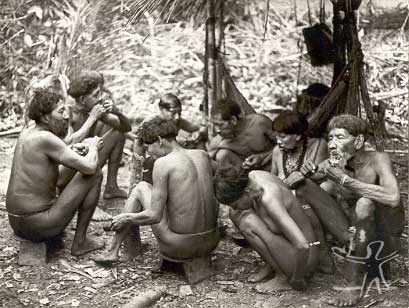
Among the changes, the Funai agent Antonio Cotrim emphasized the likelihood of extending the iron ore province of the Serra dos Carajás up to the right bank of the Xingu, which meant bringing “into the scenario of disputes over tribal territory new protagonists: the powerful southern consortium of US Steel and CVRD (Companhia do Vale do Rio Doce)" (Soares,1971b: 4). According to the Funai agent, air reconnaissance missions located various indigenous settlements and established a program of "pacification" financed by CVRD, under the responsibility of the Catholic missionaries Anton and Karl Lukesch.
For Monsignor Anton Lukesch, "to contact one of the few really isolated and unacculturated societies that still survives in the modern world and to study, understand, and make known their aboriginal way of life represents the most cherished dream of every ethnologist”. Besides that, Lukesch justified their expedition as a kind of “participation” that became urgent in order “to avoid dramatic and tragic interethnic confrontations" with the coming of the Trans-Amazon (1976:9). At the same time, Antonio Cotrim Soares alleged that :
"In part, respect for the territory of the Asurini really depends more on the absence of disputes over economic interests than on fear of violent contacts, since it is well-known in the Xingu how armed expeditions have been promoted and financed by powerful bosses, against indigenous groups, that have prevented the expansion of rubber extraction activities. As can be seen, it was the absence of native rubber stands that preserved the territorial autonomy of the Asurini" (1971b:13).
In the 1970s, persecuted by enemy groups to one side, and “pacified” by the interests of a multinational company on the other, the Asurini had no other option but to accept contact. Father Lukesch (1976:18) recounts how an Indian made gestures indicating that he wanted the expedition to go away, at the time of the first encounter, but other Asurini took the initiative and attempted to establish direct and friendly relations with the Whites.
During this time, intertribal fights occurred and, according to Takamui, an Asurini more than fifty years old, his people had to flee from the Araweté, moving in the direction of the Piranhaquara and Ipiaçava in order to make alliances with the Whites who were already there. Not only were the Lukesch brothers on their trail, but also Funai maintained attraction expeditions in this area. Soares describes the activities of the expedition that he led during its second penetration into the area of the Ipixuna (January/February, 1971), such as the visit to one of the inhabited villages and the documentation that he gathered through photographs and recordings. There is a detail in his report worth citing - "The existence of an abandoned communal maloca" (1971a:3) – which provides evidence of what was happening among these groups. The existence of wooden objects and ceramics decorated with geometric designs and the communal house are evidence of an Asurini village, occupied by the Araweté, whose inhabitants had fled after an attack by that group.
In April, 1971, the expedition led by Lukesch, which was better financed than the poor attraction expeditions of Funai, contacted the Indians of Ipiaçava, forcing Cotrim Soares to change the route of his expedition and take over the activities of the priests, since the priests’ activities were prohibited by the indigenist agency (Soares,1971b:5).
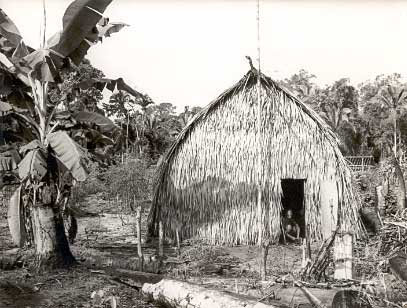
Cotrim interpreted the peaceful approximation of the Asurini to the Whites as a solution to their desparate situation: "among them (the Whites), they would have a secure refuge against the hostilities of their enemies – or even allies for a future vendetta". The Asurini had no better luck with the Funai expeditions than with the Austrian missionaries, the Lukesch brothers. According to Cotrim, Funai prohibited the activities of the priests "due to the grave harm they had involuntarially caused to the community" (1971b:5). Due to the Lukesch expedition’s failure to adopt preventive measures, the group was “contaminated” by a violent epidemic of flu and measles, resulting in 13 deaths and a long period of recovery, which affected the entire group.
Cotrim, at the same time, admitted that there also was a certain lack of preparation on the part of Funai. For example, the members of the penetration expeditions were not vaccinated. In the words of the Funai agent, "Another thing that happened that did not go unnoticed was the delay of our action in controlling the epidemic outbreak, for we didn’t have immediate resources at our disposal, given the bureaucratic obstacles in liberating them" (1971b:6).
The difficulties in continuing the work with the Asurini and the disenchantment of Antonio Cotrim Soares with the “indigenous cause" became public at the time of his declarations to the press that he refused to continue being a “gravedigger of Indians” and denounced the work conditions in Funai:
"at the moment of contact, the first consequences become evident: ... contagious diseases, depopulation, food crisis and signs of their inevitable dependence on the national society. A series of factors have contributed to these consequences, the principal and pivotal one being the lack of rationale in the method developed in this phase of contact – so-called by the promoters of catechization [i.e., the Lukesch brothers]. The negative effects have derived from the lack of preventive measures, the inconsequential distribution of gifts, the lack of selection and control of the contact team in their relations with the Indians – it seems to us that this method of establishing presence in contacts with isolated groups, has turned into a peculiarity, without the exclusivism of its promoters. On the first level, the most terrible results have been of a biotic nature, besides the high mortality, for these have debilitated them organically for a long time. The most affected by ‘fatalism’ were the elders. The vicissitudes of depopulation effects began to affect their social organization; the domestic groups became acephalous, initially disorganizing their productive force. Their whole social life was affected, principally their economic activities which stagnated due to a lack of labor force. The general state of debilitation lasted for more than two months. As a result of this state, they missed the season for preparing the soil, and only a small percentage of the work initiated was actually of any use".
On another occasion he said:
"Their daily life is one of destitution since the first demonstrations of disenchantment have arisen, despite the fact of their being provided with food supplied by the Whites. Presently, the basis of their food diet is manioc cereal provided by Funai, complemented with reduced rations of sweet-potato, manioc, and other foods gathered from their gardens".
And further:
"The food quota provided by Funai is insignificant in relation to the minimum caloric intake recommended by the dietary table; the average quota of the daily supply of manioc cereal is 12 kilos for 40 Indians – representing about 300 grams per person per day. Added to these factors, we have the psychological traumas: the technological contrasts, the sophisticated habits, intervention in their medico-religious behavior (the adoption of medicinal techniques with chemical pharmaceutical products) among the immediate effects which, perhaps, have already been put into confrontation in this phase of contact" (1971b: 23-24).
Dismissed from Funai, Cotrim abandoned his career as indigenist and the Asurini continued to suffer the effects of contact. The Indians say that, after Cotrim left, another member of the attraction expedition was left behind among them and reached the point of even being “without any sugar". The Indians themselves decided to go alone to Altamira to look for supplies, tricking the head of the Post by telling him that they were going on a hunting expedition. The episode is told today with much humour, but it reveals the state of abandonment in which they were left after being “pacified.”
In the 1980s, acting on the recommendation of the anthropologist Berta Ribeiro – who was present among the Asurini in 1981 -, the National Secretary of Cimi (The Indigenist Missionary Council) succeeded in getting authorization from the then President of Funai, Coronel Paulo Leal, to send two missionaries of the group Little Sisters of Jesus to work among the Asurini of the Xingu. They arrived in the village in mid-1982, bringing with them a long and successful experience of support in the recovery of the Taripapé, also a Tupian people, who live near in the Araguaia River(MT) and who had gone through a similar process of depopulation after contact. The missionaries did not want to formally assume any assistance activities, substituting the obligations of Funai. At the time, no type of agreement between them and Funai was formalized, and the missionaries made it clear that what they would be doing was a sort of “parallel action, of guidance and knowledge of the problems of the group during its process of recovery".
Way of life
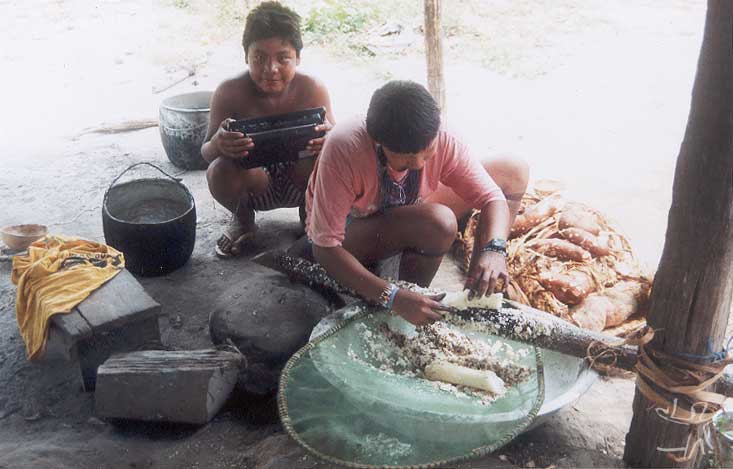
In the Asurini village, there are different types of dwelling-places, the most common, where different domestic groups reside, are like the houses built by the regional population, that is, with mud walls, wooden structure, and thatched roof. The largest house of the village (aketé, tavywa), measuring approximately 30 meters in length, 12 meters in width and 7 meters in height, corresponds to descriptions of dwelling-places characteristic of the Tupi: the layout of the house is rectangular. The placing of the poles, beams, and crossbars follow the pattern necessary for the construction of the basic domed- shape structure. In this sense, it differs from the others in having a more elaborate structure. For the covering, only the sprouts of palm leaves are used and for the structure specific species of trees are used for each support. The whole group participates in the construction of the house, under the leadership of those who will eventually live in the house. The dead are buried in the ground inside the house and there also, the main cerimonies of the Asurini are held.
Traditionally, the aketé or tavywa was the collective dwelling-place of a local group. However, while they were together at the Funai Post, the Asurini reorganized into a group formed by individuals of different local groups with a population demographically imbalanced, due to the population decrease. As Soares (1971b:23) observed, since the time of contact the deaths of more elders has weakened the political structure of the group, since it was amongst the elders that the Asurini chose their leaders. The majority of the men are shamans (pa(z*)é) and the intensification of shamanistic rituals must be related to Asurini efforts to reorganize their group.
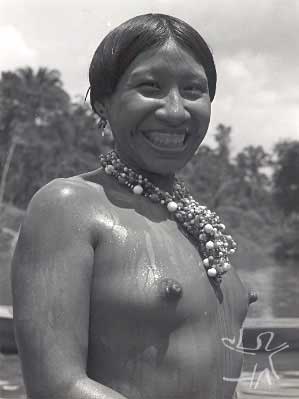
The composition of the domestic groups reveals a social structural tendency typical of Tupi groups, but also one observes an instability resulting from demographic imbalance. There is a certain similarity between Asurini and Tenetehara social organization, for whom, according to Wagley and Galvão (1961:39), "in essence, the extended family is a group of women related by kinship under the leadership of a man”. The residence rule is uxorilocal and the men who belong to a domestic group, through marriage to women related by kinship, maintain relations of cooperation in subsistence activities. In the nuclear families, there are several cases of polyandry. In these cases, the eldest woman has already passed the age of procreation and the youngest devotes herself entirely to ritual activities (they are the singers who accompany the pajés), to the learning of graphic art (body painting and decoration of ceramics) and helping their “mother” in basic activities such as gardening, gathering, cooking, weaving, and ceramics).
The Asurini woman marries in adolescence but she will only have her first child when she becomes a young adult (approximately 25 years old). Until then, she will be learning and perfecting her abilities in subsistence tasks, in such a way that she will participate in the rituals as a singer. The making of ceramics, highly valued among the Asurini (both aesthetically and from a utilitarian point of view), also can be defined as an activity that excludes a woman’s procreative functions. There are Asurini women who have never had children (today they are over 45 years of age), among whom there are highly accomplished artists.
Another condition for procreation is the existence of two husbands, one young and one old. During pregnancy, up to the fourth month, various men participate in the formation of the fetus and have frequent sexual relations with the woman so that the child is “born strong.” During seclusion, only the two fathers married to the mother will maintain sexual relations with her. The elder father will have the main responsibility for educating the child, if it is a boy. For the younger father, the birth of the first child marks the passage from one age category to another (this passage is not formally ritualized by the Asurini). One of the justifications the women make for marriages without children is the absence of the younger father (iau n´ative).
Economic activities
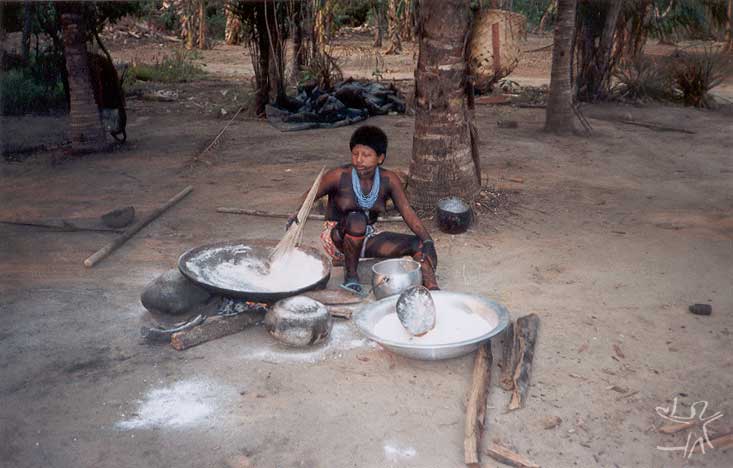
Besides hunting, fishing and gathering, agriculture is the main subsistence activity of the Asurini, and manioc represents the basic element of their diet. In their gardens they cultivate various species of manioc, consumed in different ways, manioc cereal being the principal product. This is made in three traditional ways:
1) ui´eté: after scraping the manioc on paxiuba (a palm with thorny roots) (pat(s*)i iwa), the pulp is squeezed with the hands and placed into a trough to dry; after dried, it is pounded and shaped into balls, that are later placed over the fire to be smoked and then they are pounded again and sifted; then the manioc cereal is toasted over the earthen oven(d(*z)apé);
2) maniakapyaka: made of manioc pulp that is placed in the bottom of great pots, along with the squeezed juice; after it is dried in the sun and pounded, it is toasted;
3) maniakui: made of manioc soaked in water for several days, dried in the sun, pounded and finally toasted. They also eat manioc bread (beiju) and various types of porridge (mingau) prepared with the juice of sweet manioc (maniakawa) or thickened with wild manioc (maniaka), soaked and pounded, and later dried in the sun (maniapywa).
They also cultivate corn (for which there are restrictions to be followed in its planting), yams, sweet potato, tobacco, cotton, urucum, peanuts, beans, watermelon, bananas. Following the sexual division of labor, it is up to the men to prepare the soil (cutting, felling, burning, and secondary burning) and to the women the planting and gathering.
The men of a domestic group maintain relations of cooperation amongst themselves, clearing gardens near to each other. For felling, all the men of the village are invited and are served a porridge. The production is the women’s domain and they, transforming what is planted into food, distribute it to the other domestic groups according to the rules of kinship.
Gathering is an activity that men and women do. The principal products of gathering are castanhas-do-pará (nh(?)), the inajá fruit (inóa(*z)á), babaçu (ú(*z)anúy) fruit and the turtle, one of the favorite dishes of the Asurini. Hunting is a male activity and the animals hunted are the following, by order of preference: wild pig (ta(*z)aho), cotia (akut(*s)i), mutum (mytum), jacu (d(*z) aku), inhambu (inabo) and caetetu (t(*s)iwá).
Collective fishing is done in the summer, in the streams, lakes, and places of the Ipiaçava that permit the use of traditional techniques, such as plant poison (timbó) in water that is naturally dammed-up or through the construction of earthen dams. The fish are shot with arrows or gathered in baskets. Completing this equipment, they use a series of traps and, in the winter, they generally fish with hooks and nylon line.
Material culture
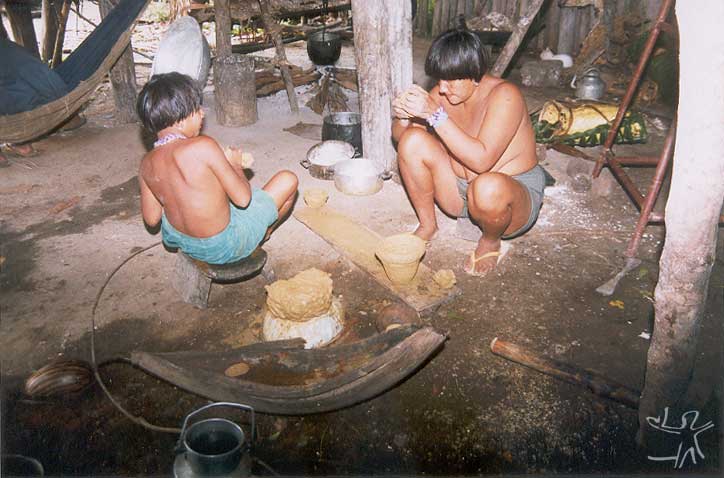
Asurini material culture includes the following items: ceramics, weaving, basketry, weapons, body ornaments, wooden benches and musical instruments (flutes). Ceramics and weaving (hammocks, slings, headbands and other ornaments made of cotton) are the women’s tasks. Ceramic pots serve as recipients to transport and deposit water, serve food and prepare it over the fire. In the latter case, these are earthen vessels which have become black with use. For other uses, ceramics are decorated with geometric designs.
Ceramics are prepared from a clay that is obtained from deposits two or three kilometers away from the village, located near the banks of the Xingu River. The vessels are made by using the technique of cording, that is, the overlaying of rolls of clay. The form of the vessel takes shape from the fusion of the rolls together and with the help of a spatula made from a gourd (kutiapé). With this also, the potter does the initial smoothing of the piece which will later be complemented during the drying of the piece, using the fruit of the inajá (Maximiliam Régia) or a rolling stone. The border of the vessels is usually shaped with the fingers or by using a species of lichen that makes it fine and uniform. After drying, the vessel is initially burned, being placed near the fire until its surface appears very dark. Later it is burned in an oxidizing atmosphere with the barks of different types of trees.
The final touches on the undecorated pieces are made by applying a layer of a substance contained in the inner bark of the stalk of a tree (t(*s)it(*s)i´wa), giving them a reddish-brown color. In the painting of the decorated pieces, mineral raw material is used, that is, small stones of three colors: yellow (itawá), red (itawapiringi) and black (itawaondi). These stones are rubbed onto another larger one, thus producing the dye. The yellow one is used as a base, painting the entire external surface of the piece with this color. The black and red are used in the elaboration of geometric designs. These are done with paintbrushes that can be made of small pieces of wood covered with cotton, palm leaf stems, plant stems or mutum feather fibre. After finishing the painting, the piece is left to dry. Afterwards, a layer of resin from the jatobá tree (hymenaea), called dzotaika, is passed over the external surface of the piece, polishing it and fixing the dye.
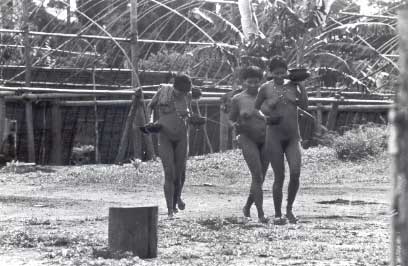
Besides ceramics, geometric designs also decorate the gourds (incised), bows and ornaments (traced). From a vast repertoire of motifs and patterns of designs used in the decoration of these items of material culture, there are those that are used to ornament the body, either by tattoing or painting with genipapo. These designs are stylizations of elements from nature, as well as representations of supernatural beings or symbolic elements, such as Anhynga kwasiat (a mythical being that gave the design to men) and Taingawa (a doll used in shamanic rituals and that also means “image, model, replica of the human being”).
The system of graphic art
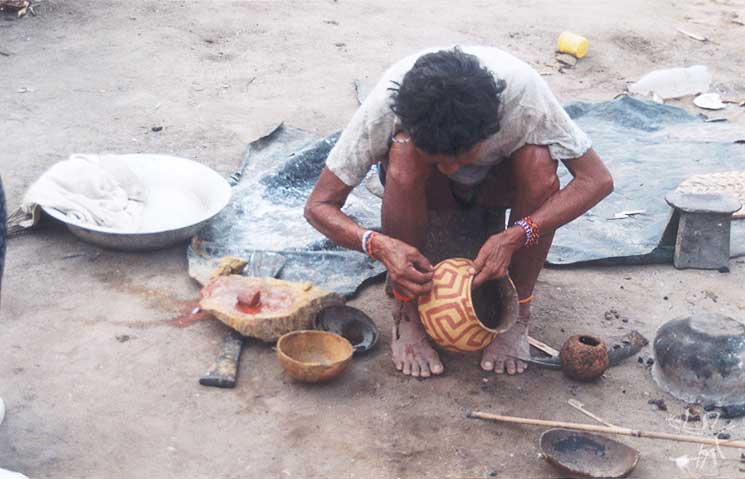
The geometric designs used in the decoration of the body, ceramics, gourds and other items of Asurini material culture comprise a system of graphic art, with its own grammar and the contents of which are related to different systems of meaning. These designs are stylizations of elements of nature, as well as representations of supernatural beings or symbolic elements such as Anhynga kwasiat (the mythical being who gave the design to men) and i (the doll used in shamanic rituals and which also means “image”, “model”, “replica of the human being”) respectively.
The first motif also appears in the design made by the men, used in the decoration of cerimonial bows and body decorations. There are various stylized elements from nature: intertwined lianas in the forest (kapuenwi), large bean (kumandaoho), turtle foot (dzawotsipa(*p)era), monkey tail (kaiwarinhyna), honeycomb (ehiraimbawa) and the occipital part of the painted jaguar (d(*z)awara(*z)orywa), for example.
There are design motifs that bear the name of the surfaces to which they are applied: tamaki(*z)oak (leg painting), kuaipei (head designs), d(*z)a´ek(~y) (head of the d(*z)a´é, name for one of the pieces of ceramics on the border of which this decorative motif is used). The labial ornament called Tembekwara is also stylized, the design representing one of its parts, the name of which is given to the motif: tembekwá reropitá.
In body decorations, the meaning of this artistic manifestation is related to the social categorization of individuals. The motifs for painting are common to both sexes. The division of the body as a criterion for distribution of the designs, nevertheless, differs according to sex. Among the women, the womb is marked by a design that divides the front part of the body in two, vertically.
Among the men, this division is made horizontally, that is, following the same division of tattoos: the design on the shoulders (d(*z)etii´iwapawa) and horizontal lines, from shoulder to shoulder, delimit the upper part which is not painted. Tattooing marks, in the men, their participation in the activities of war and, in the women, the phases of biological and social development.
Shamanism
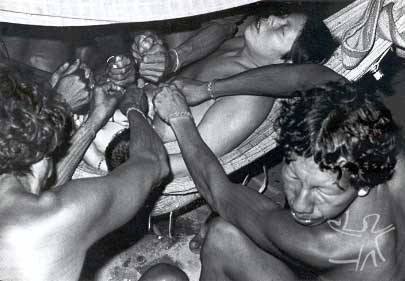
Among the Asurini, shamanistic rituals, known as "pajelança", are performed frequently, mobilizing the whole group. The majority of the men participate as pajé in these rituals, helped by assistants and by the women singers, who also have the task of preparing ritual porridge. "Pajelança" (shamanism) includes two types of rituals: the maraká (song and dance) and the petymwo (massage and smoke treatment), executed in order to invoke the spirits with whom the shamans enter into contact, as well as to remove the cause of the sickness from the body of the patient and to transmit to the body the “remedy” (muynga) that the shamans receive, at that time, in the state of transe (therapeutic rituals). In these rituals, the shaman also transmits to the patient and the children of the village ynga, something like “vital force”, translated in Asurini as “heart”, that is, that which beats, that has life. The maraká is also realized as a propitiatory ritual for spirits identified as animals of the forest, like wild pig (ta(*z)aho) and deer (arapoá).
The shamans enter into contact with spirits that fit into the categories of what can be called “guardian spirits", subdivided into species that include individuals identified by proper names. These beings, who reproduce the world of the humans, inhabit certain regions of the cosmos. They are intermediaries between the shamans and another category of beings not identified individually and who do not enter into direct contact with the shamans, and which can be called “unique categories".
The guardian spirits mediate between the shamans and the unique categories, and the shamans between the spirits and men. In accordance with the existing hierarchy between spirits of the Asurini cosmos, humans are subordinate to the creatures classified as unique categories and who are of a superior plane, as well as the anhynga, who are of an inferior plane and who live with the Asurini, and can cause harm to them, for they represent negative forces, like the souls of the dead.
Like the shamans, the guardian spirits are intermediaries between men and the unique categories and assist humans to combat the evils of the anhynga. In order to become familiar with the spirits and participate in their world, the Asurini shaman goes through an initiation, that is, a training in order to attain and control the state of transe – interpreted as the “death”of the pajé, from spirit attacks -, through dance and the blowing of tobacco smoke. In order to support these attacks, the pajé manipulates substances (ka´a) that enter into his body. The training of the shaman consists in “taking them” from the spirit in question. He also should learn how to handle certain instruments, such as whistles, that make the sound of the spirits and come from the supernatural world.
The other, more common, interpretation of sickness is that it is the result of the action of spirits due to the transgression of prohibitions related to the supernatural world, for example, speaking the name of the Karowara spirits near the rivers and streams, or having contact with anhynga. The sickness can be understood as a manifestation of the predisposition of the individual to become a shaman. From the point of view of Western medicine, the cases treated by the shaman are flu, malaria, tuberculosis, etc.
Besides the rituals realized for the health of the inhabitants of the village, the shamans perform propitiatory rituals to guarantee subsistence, such as the Tazaho (wild pig) ritual in order to attract and locate the herds of this animal in the forest. Another propitiatory ritual, performed together with the wild pig ritual, is the Arapoá (deer) which recalls the myth in which this animal gave garden products to women, in a time when the Asurini didn’t know these products.
Along with the therapeutic and propitiatory rituals, there are others dedicated to the newborn and the shamanistic rituals of Toré (flute cerimonial complex), in which spirits such as Tau and Kawara are invoked. The Asurini shaman is the central figure in the performance of the social life of the group. His free transit through the various domains of the cosmos allows him to have control over forces that ensure the resistance of the society against all odds. With contact and its consequences of depopulation, the cultural emphasis on shamanism – latent among the Asurini and recurrent among Tupi-Guarani groups -would have developed in an exacerbated way.
The initiation of Boaiwa
The following case was witnessed by Regina Müller: on returning from an abundant turtle hunt, Boaiwa announced in the village that he had seen five Tiwá (jaguar spirits). Momuma commented on this sign: when one sees Tiwá, a war with enemies is approaching. And he continued: wild Indians are coming to fight. Tiwá is the jaguar, inambu, jacu, mutum. It is all the whites, who have white beards. The pajés, who are Tiwá, eat deer meat as do jaguars. These conversations preceded the preparations for the great ritual turtle banquet and the shamanic ritual to invoke the spirit of the Jaguar, which lasted from 21 to 25 February, 1981. Boaiwa was the principal figure in these events. As a warrior (mboakara), he offered food to everyone in the group so that the dead of the enemy would not “cause any evil”.
At the beginning of March, Boaiwa’s health worsened. He was coughing a lot and, when an outbreak of flu spread through the whole village, he began to throw up blood. The community mobilized around a shamanic ritual (of the Karowara spirit). Boaiwa, meanwhile, did not assume the position of patient to receive the spiritual treatment of the shaman. To the contrary, he sat in the circle of shamans and participated with them in the ritual meal and cigar-smoking.
The Asurini said that Boaiwa was not sick, but was turning into a shaman (pazé opotara). Thus, he could not take more injections, since the medication hindered his contact with the Tiwá. It was necessary for him to learn how to dominate the contact, which would only happen when he “got” ka´a (the spirit substance that enters into the body of the pajé). At the moment of the initial contacts of the Tiwá with the pajés, Boaiwa struggled, threw himself onto the ground, walked and twitched like a jaguar. The women stayed close to the houseposts, warding Boaiwa off so that he would not hurt them. The experienced pajés controlled the spirit. Their bodies became inert with their loss of consciousness.
Boaiwa was only beginning his apprenticeship. He would have to smoke many cigars, dance, fast, and “get” Tiwá. Various shamanic rituals then followed so that the new shaman could practice. In this context, at the request of the shamans, the medication that the Funai nurse was giving to him was suspended. The Asurini asked me to explain to the nursing attendant why Boaiwa could not take any more injections, causing a misunderstanding between me and the local Funai agents.
The maraká of the Tiwá continued intense, medication was suspended, with Boaiwa vomiting blood. They would only stop when he succeeded in controlling the agressivity of the spirit, who was shooting arrows against his body. Despite the care that his family gave him, Boaiwa, after several days, showed signs of exhaustion and wounds on his body, the result of his having thrown himself on the ground and against the houseposts. The blood that came out of his mouth was attributed by the Asurini to the carnivorous habits of the Tiwá.
On March 6, I went into the house where the rituals were being realized and found Boaiwa alone, in his hammock, trying to stop the blood that came from his mouth. With his eyes wide open, he asked to be taken to Altamira because he was going to die. In these circumstances, the shamans, grouped around Boaiwa’s hammock, ended up agreeing to the application of anti-hemorrhage medication. Just one injection. Two days later, Dr. Frederico Ribeiro, a doctor sent by the Funai headquarters in Brasília, arrived in the village to stay two months in the village of the Asurini, “Indians threatened with extinction".
Boaiwa’s health improved and the blood stopped coming out of his mouth. The "exercises" to transform him into a pajé continued intensely, for more than a month, even against the recommendations of the nurse attendant and the doctor. For a long time, Boaiwa was the youngest pajé of the Asurini of the Xingu. Today, however, his grandsons Imudi´i (11 years old) and Parajuá (15 ) are the most recently initiated.
Notes on the sources
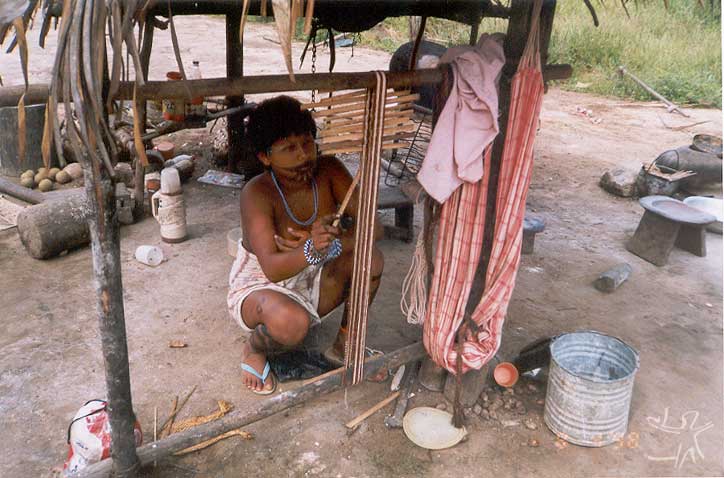
Those interested in knowing more about the graphic art and body adornments of this population, as well as general information should consult the article by Berta Ribeiro, published in 1982, called “A Oleira e a Tecelã”[ The Potter and the Weaver], in no.26 of the Revista de Antropologia. There is also the text entitled “Pintura e Adornos Corporais” [Body Painting and Adornments], by Lux Vidal and Regina Müller, published in the third volume of the collection Suma Etnológica Brasileira, in 1987. There is also a book by Regina Müller, called Os Asurini do Xingu (História e Arte)[The Asurini of the Xingu (History and Art)], published in 1990, and the article “Tayngava, a noção de representação na arte gráfica”[ Tayngava, the notion of representation in graphic art], which is a chapter of the classic collection called Grafismo Indígena, edited by Lux Vidal, in 1992. Finally, there is the Doctoral thesis in Social Anthropology by Fabiola Silva, defended in 2002 at USP, entitled As Tecnologias e seus significados [Technologies and Their Meanings].
Sources of information
- AGUIAR, Gilberto F. Souza; GUERREIRO, João Farias; SANTOS, Sidney Emanuel Batista dos. Interindividual genetic relationships in an Amazonian indian village. Boletim do MPEG, Série Antropologia, Belém : MPEG, v. 9, n. 2, p. 171-97 , dez. 1993.
- ARAÚJO, Ana Valéria (Org.). A defesa dos direitos indígenas no judiciário : ações propostas pelo Núcleo de Direitos Indígenas. São Paulo : Instituto Socioambiental, 1995. 544 p.
- ARNAUD, Expedito. Mudanças entre os grupos indígenas Tupi da região do Tocantins-Xingu (Bacia Amazônica). In: --------. O índio e a expansão nacional. Belém : Cejup, 1989. p. 315-64. Publicado originalmente no Boletim do MPEG, Antropologia, Belém, n.s., n. 84, abr. 1983.
- COUDREAU, Henri. Viagem ao Xingu. Belo Horizonte : Itatiaia ; São Paulo : Edusp, 1977. 166 p.
- ETNOARQUEOLOGIA : a tecnologia ditada pelo coração. Pesquisa Fapesp, São Paulo : Fapesp, s.n., p.40-2, out. 1999.
- FRANCHETTO, Bruna. Laudo antropológico : a ocupação indígena da região dos formadores e do alto curso do rio Xingu. Rio de Janeiro : s.ed., 1987. 159 p.
- JANGOUX, Jacques. Preliminary observations on shamanism, curing rituals and propitiatory ceremonies among the Asurini indians of the middle Xingu in Brazil. Arquivos de Anatomia e Antropologia, Rio de Janeiro : Instituto de Antropologia Prof. Souza Marques, v.2, n.3, sep., p.11-76, 1978.
- LO CURTO, Aldo Giuseppe. Asurini, gli artisti della giungla. Prosito : BSI, 1995. 32 p.
- LUKESCH, Anton. Bearded indians of the tropical forest : the Asurini of the Ipiaçaba. Notes and observations on the first contact and living together. Graz : Akademische Druck, 1976. 147 p.
- --------. Kontaktaufnahme mit Urwaldindianern (Brasilien) : Die Asurini im Xingu-Gebiet. Anthropos, Fribourg : Internationale Zeitschrift für Völker, n. 68, p.801-14, 1973.
- MÜLLER, Regina Aparecida Pollo. Os Asuriní do Xingu : história e arte. Campinas : Ed. da Unicamp, 1993. 350 p. (Série Teses)
- --------. Os Asuriní do Xingu. In: SANTOS, Leinad Ayer O.; ANDRADE, Lúcia M. M. de (Orgs.). As hidrelétricas do Xingu e os povos indígenas. São Paulo : CPI, 1988. p.173-8.
- --------. Contexto histórico, reproducción y noción de representación entre los Assurini del Xingú : el análisis del discurso en el estudio de las sociedades indígenas. In: BASSO, Ellen B.; SHERZER, Joel (Coords.). Las culturas nativas latinoamericanas a traves de su discurso. Quito : Abya-Yala ; Roma : MLAL, 1990. p. 395-416. (Colección 500 Años, 24).
- --------. Corpo e imagem em movimento : há uma alma neste corpo. Rev. de Antropologia, São Paulo : USP, v. 43, n. 2, p. 165-94, 2000.
- --------. As crianças no processo de recuperação demográfica dos Asurini do Xingu. In: SILVA, Aracy Lopes da; MACEDO, Ana Vera Lopes da Silva; NUNES, Angela (Orgs.). Crianças indígenas : ensaios antropológicos. São Paulo : Global ; Mari, 2002. p.188-212.
- --------. De como cincoenta e duas pessoas reproduzem uma sociedade indígena, os Asurini do Xingu. São Paulo : USP, 1987. 385 p. (Tese de Doutorado)
- --------. Muertos y seres sobrenaturales, separación y convivencia : principios cosmológicos en la concepción Asurini de la muerte. In: CIPOLLETTI, Maria Susana; LANGDON, E. Jean (Coords.). La muerte y el mas alla en las culturas indígenas Latinoamericanas. Quito : Abya-Yala ; Roma : MLAL, 1992. p. 77-90. (Colección 500 Años, 58)
- --------. Tayngava, a noção de representação na arte gráfica Asurini do Xingu. In: VIDAL, Lux (Org.). Grafismo indígena. São Paulo : Edusp ; Studio Nobel ; Fapesp, 1992. p.231-48.
- RIBEIRO, Berta. A oleira e a tecelã. Rev. de Antropologia, São Paulo : USP, v.26, p.25-61, 1982.
- SILVA, Fabíola Andrea. As tecnologias e seus significados : um estudo da cerâmica dos Asurini do Xingu e da cestaria dos Kayapó-Xikrin sob uma perspectiva etnoarqueológica. São Paulo : USP, 2000. 244 p. (Tese de Doutorado)
- SOARES, Antônio Cotrim. Relatório apresentado pelo sertanista sobre contatos com os índios Asurini. PI Koatinemo : Funai, 1971. 62 p.
- SOUZA, Maria Luiza Rodrigues. Nomes e história do contato entre os Assurini do Xingu. São Paulo : USP, 1994. (Dissertação de Mestrado)
- A tecnologia ditada pelo coração : índios do Xingu definem seus processos técnicos por razões simbólicas. Pesquisa Fapesp, São Paulo : Fapesp, s.n., p. 40-2, out. 1999.
- VIEIRA, Márcia Maria Damaso. O fenômeno de não-configuracionalidade na língua asurini do trocara : um problema derivado da projeção dos argumentos verbais. Campinas : Unicamp, 1993. 274 p. (Tese de Doutorado)
- VIDAL, Lux; MÜLLER, Regina Aparecida Pollo. Pintura e adornos corporais. In: RIBEIRO, Berta (Coord.). Suma Etnológica Brasileira. v.3: Arte Índia. Petrópolis : Vozes, 1986. p.119-50.
- Morayngava. Dir.: Regina Müller; Virginia Valadão. Vídeo Cor, 16 min., 1997. Prod.: CTI
- Ritual das Flautas. Dir.: Delvair Montagner; Regina Müller. Vídeo Cor, Beta-SP/HI 8, 34 min, 1996. Prod.: CPCE/CNPq.
- Saforai. Dir.: Regina Müller. Vídeo cor, Hi-8/NTSC, 23 min., 1993.